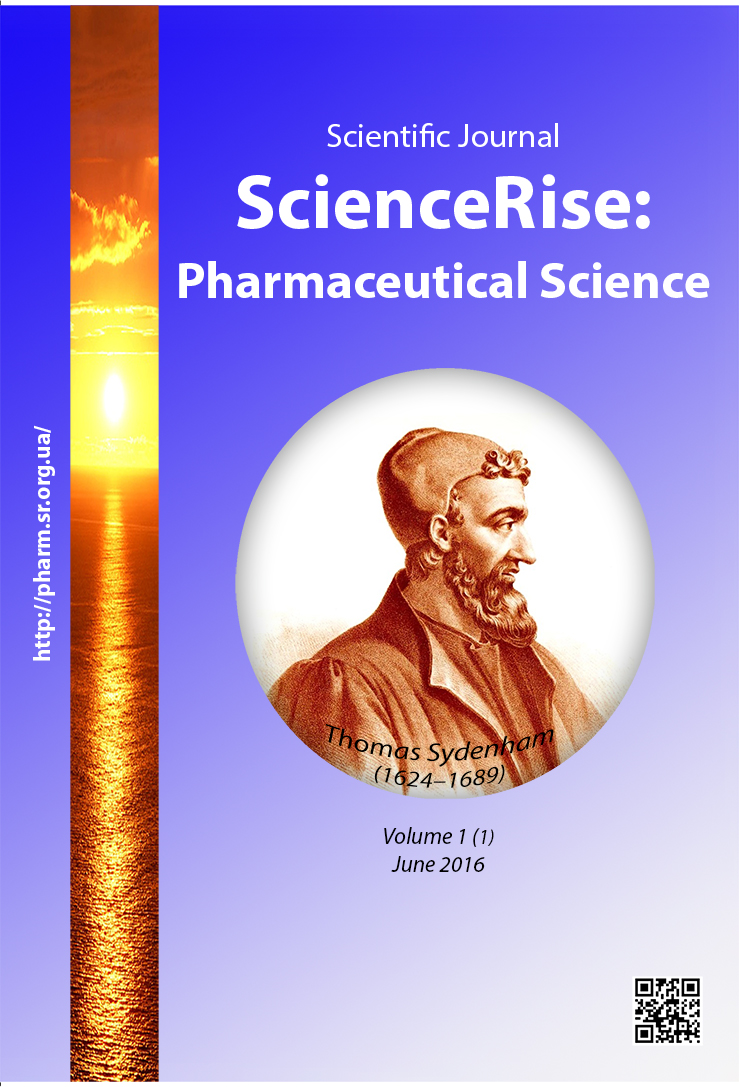Phytochemical study and determination of pharmacological activities of cherry shoots dry extract
DOI:
https://doi.org/10.15587/2519-4852.2016.72746Keywords:
cherry, extract, flavonoids, sugars, hydroxycinnamic acids, anti-inflammatory activity, acute toxicityAbstract
Aim. The aim of our research was investigation of phenolic constituents, free and connected sugars of the cherry shoots dry extract by the HPLC method and determination of acute toxicity and anti-inflammatory activity of the extract.
Methods. Qualitative composition and content of phenolic compounds and sugars in the cherry shoots dry extract were studied by HPLC, with the Agilent Technologies chromatograph (model 1100). The acute toxicity was studied after single intragastric administration of cherry shoots dry extract to rats. Studying the influence of the cherry shoots dry extract during experimental inflammation exudative mechanism was carried out on a model of acute carrageenan-induced inflammation in white rats.
Results. As a result of the study 9 phenolic compounds as derivatives of hydroxycinnamic acids and flavonoids and 5 sugars were determined. it was established the absence of toxicity of the cherry shoots dry extract in a dose 5000 mg/kg and according to toxicological classification of substances by К.К.Sidorov the cherry shoots dry extract after intragastric administration belong to V toxicity class – practically harmless substances. Cherry shoots dry extract showed the best anti-inflammatory effect in a dose of 100 mg/kg; it was about 36 % on average for 5 hours.
Conclusions. Considering results of chemical analysis and determination safety and antiinflammatory activity we can assume that the cherry shoots dry extract can demonstrate analgesic and antiallergic effect, so it is promising for further study in order to create a new effective and safe drugs for use in medical practiceReferences
- Upyr, L. V.; Chernykh, V. P. (Ed.) (2010). Cherry. Кiev: «МОRІОN», 277–278.
- Popovich, V. P., Upyr, L. V., Kyslychenko, V. S. (2010). Effect of cherry fruit stalks and shoots dry extracts on diuresis and some indicators of nitrogen metabolism in rats. Current problems of theoretical, clinical, preventive medicine, dentistry and pharmacy. Donetsk, 280–281.
- The State Pharmacopoeia of Ukraine. Suppl. 2 (2008). Kharkiv: RІRЕG, 620.
- Gulieva, А. F., Lenchyk, L. V. (2015). Phytochemical study of phenolic compounds cherry extract. Innovations in Medicine and Pharmacy. Minsk: BSMU, 836–838.
- Court, W. A. (1977). High-performance reversed-phase liquid chromatography of naturally occurring phenolic compounds. Journal of Chromatography A, 130, 287–291. doi: 10.1016/s0021-9673(00)89807-6
- Mabry, T. J., Markham, K. R., Thomas, M. B. (1970). The Systematic Identification of Flavonoids. New York: Springer-Verlag. doi: 10.1007/978-3-642-88458-0
- McMurrough, I., Hennigan, G. P., Loughrey, M. J. (1982). Quantitative analysis of hop flavonols using high-performance liquid chromatography. Journal of Agricultural and Food Chemistry, 30 (6), 1102–1106. doi: 10.1021/jf00114a024
- Zapadnyuk, I. P., Zapadnyuk, V. I., Zechariah, S. А. (1983). Laboratory animals: breeding, keeping and using in experiment. Kyiv: Vishcha shkola, 552.
- Kovalenko, V. М., Stefanov, О. V., Maximov, Y. M., Trachtenberg, I. M.; Stefanov, A. V. (Ed.) (2001). Experimental study of toxic effects of potential drugs / Preclinical studies of drugs. Kyiv: Avicenna, 74–97.
- European convention for the protection of vertebrate animals used for experimental and other scientific purposes (1986). Council of European. Strasbourg, 123, 51.
- Stefanov, O. (Ed.) (2001). Preclinical studies of drugs (guidelines). Kyiv: Avicenna, 292–306.
Downloads
Published
How to Cite
Issue
Section
License
Copyright (c) 2016 Larysa Lenchyk, Olga Shapoval, Viktoria Kyslychenko

This work is licensed under a Creative Commons Attribution 4.0 International License.
Our journal abides by the Creative Commons CC BY copyright rights and permissions for open access journals.








